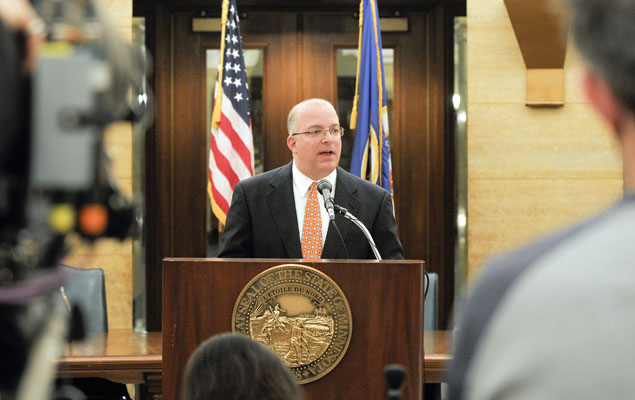First Reading: A grim forecast
By Nick Busse
“It could be worse” was about the best news that State Economist Tom Stinson had to offer Feb. 28 as he presented the Department of Finance’s grim February Forecast, which predicts a $935 million budget shortfall for the remainder of the 2008-09 biennium.
Stinson and Finance Commissioner Tom Hanson explained that the figure, which represents a drop of $530 million from the November Forecast projections, is being driven by widespread economic stagnation both in Minnesota and elsewhere.
 “The story of this forecast continues to be the weakening U.S. economy,” Hanson said.
“The story of this forecast continues to be the weakening U.S. economy,” Hanson said.
Stinson noted that the revenue decline was particularly dramatic when compared with last year’s end-of-session projections, which were $1.27 billion higher. By far, the biggest driver has been a steep decline in corporate tax receipts, down 20.6 percent, or $456 million.
The forecast also predicts a $1.09 billion deficit for the 2010-11 biennium; however, adjusted for spending inflation, that figure is actually more than $2.1 billion.
Despite the daunting numbers, Hanson called the situation “very concerning but still manageable.”
Different approaches emerge
How this situation is going to be managed may turn out to be the defining theme for the remainder of the legislative session. Gov. Tim Pawlenty said his office will release a modified budget proposal sometime next week that will recommend spending cuts to various state agencies. Above all, the governor rejected any proposals to increase taxes.
“Our goal is not to increase revenue. We’re already spending too much,” Pawlenty said.
House Speaker Margaret Anderson Kelliher (DFL-Mpls) pledged that legislators would close the budget gap “by the time we leave this session.” She agreed with the governor that budget cuts will likely be a necessary part of the solution; however, she noted that any cuts should be made “with a scissors and not an axe.”
Speaking at a press conference after the forecast’s release, Kelliher and other DFL leaders emphasized job creation as one of their top priorities for the session, arguing it would provide long-term economic growth and help generate new revenues for the state.
The DFLers were less clear as to whether they would seek more immediate sources of revenue.
Asked whether they would consider pushing for any tax increases, Senate Assistant Majority Leader Tarryl Clark (DFL-St. Cloud) replied, “We don’t answer hypotheticals.”
Kelliher, meanwhile, said that House DFLers would indeed consider raising revenues by closing tax loopholes for foreign operating companies. Pawlenty indicated he would consider such a plan, but only if the new revenues were tied to some kind of tax relief in other sectors.
House Minority Leader Marty Seifert (R-Marshall) was less nuanced in his reaction to the forecast.
“No tax increases, period,” Seifert said.
Seifert indicated that he and other House Republicans would press for spending reductions to state agencies, particularly in the area of health and human services. As an example, he said reducing Medical Assistance co-pays could save the state $50 million to $250 million, “depending on how aggressive” the cuts are.
He added that the kind of accounting shifts used to fix 2003’s $4.5 billion deficit were unnecessary and not likely to be repeated.
What to cut?
Echoing Seifert’s comments, Pawlenty said health and human services spending is “devouring” the state budget, and indicated that it would be a likely candidate for budget cuts. He added that he has already ordered a hiring freeze for all state agencies to help curb administrative spending. Although he largely dismissed the possibility of layoffs of state employees, he indicated that state agencies should be prepared to make sacrifices.
“When you take money out of the state’s budget, someone’s going to be impacted. You can’t sugarcoat that,” he said.
DFLers may have different priorities.
Kelliher mentioned that the Legislature’s funding decisions may be affected by recent reports from the Office of the Legislative Auditor — a likely reference to, among other things, a recent report critical of the JOBZ economic development program.
The fate of the bonding bill is also in doubt. Pawlenty said he expects the Legislature to abide by the long-standing rule that the total amount of the bonding bill can equal no more than 3 percent of General Fund revenues; however, he expressed some willingness to negotiate with DFLers like Sen. Keith Langseth (DFL-Glyndon), chairman of the Senate Capital Investment Committee, who argues that the amount should be defined by actual instead of estimated revenues.
Session Weekly More...
Related Stories
At Issue: Deficit fixed for now
Projected billion-dollar shortfall to be erased, but long-term concerns remain
(view full story)
Published 5/30/2008
First Reading: A budget in balance
DFL plan approved by the House, differs significantly from the governor’s
(view full story)
Published 4/4/2008
First Reading: Addressing the shortfall
Balancing act puts focus on cuts and reserves — but no taxes
(view full story)
Published 3/14/2008
First Reading: A grim forecast
Facing a $935 million budget deficit, legislators prepare to tighten the belt
(view full story)
Published 2/29/2008
Feature: Going strong at 25
Session Weekly — rooted in a commitment to keep the public informed.
(view full story)
Published 2/15/2008